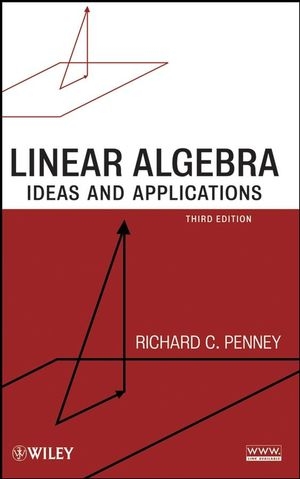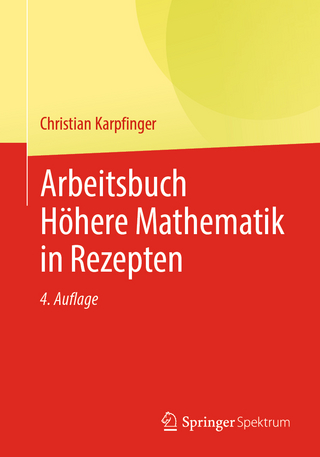
Linear Algebra
Wiley-Blackwell (Verlag)
978-0-470-17884-3 (ISBN)
- Titel ist leider vergriffen;
keine Neuauflage - Artikel merken
This expanded new edition presents a thorough and up-to-date introduction to the study of linear algebra Linear Algebra, Third Edition provides a unified introduction to linear algebra while reinforcing and emphasizing a conceptual and hands-on understanding of the essential ideas. Promoting the development of intuition rather than the simple application of methods, the book successfully helps readers to understand not only how to implement a technique, but why its use is important. The book outlines an analytical, algebraic, and geometric discussion of the provided definitions, theorems, and proofs. For each concept, an abstract foundation is presented together with its computational output, and this parallel structure clearly and immediately illustrates the relationship between the theory and its appropriate applications.
The Third Edition also features: A new chapter on generalized eigenvectors and chain bases with coverage of the Jordan form and the Cayley-Hamilton theorem A new chapter on numerical techniques, including a discussion of the condition number A new section on Hermitian symmetric and unitary matrices An exploration of computational approaches to finding eigenvalues, such as the forward iteration, reverse iteration, and the QR method Additional exercises that consist of application, numerical, and conceptual questions as well as true-false questions Illuminating applications of linear algebra are provided throughout most parts of the book along with self-study questions that allow the reader to replicate the treatments independently of the book. Each chapter concludes with a summary of key points, and most topics are accompanied by a "Computer Projects" section, which contains worked-out exercises that utilize the most up-to-date version of MATLAB(r). A related Web site features Maple translations of these exercises as well as additional supplemental material. Linear Algebra, Third Edition is an excellent undergraduate-level textbook for courses in linear algebra.
It is also a valuable self-study guide for professionals and researchers who would like a basic introduction to linear algebra with applications in science, engineering, and computer science.
Richard C. Penney, PhD, is Professor in the Department of Mathematics and Director of the Mathematics/Statistics Actuarial Science Program at Purdue University. Dr. Penney is the author of numerous journal articles and has received several major teaching awards.
Preface. Features of the Text. 1. Systems of Linear Equations. 1.1 The Vector Space of m x n Matrices. The Space Rn. Linear Combinations and Linear Dependence. What Is a Vector Space? Why Prove Anything? True-False Questions. Exercises. 1.1.1 Computer Projects. Exercises. 1.1.2 Applications to Graph Theory I. Self-Study Questions. Exercises. 1.2 Systems. Rank: The Maximum Number of Linearly Independent Equations. True-False Questions. Exercises. 1.2.1 Computer Projects. Exercises. 1.2.2 Applications to Circuit Theory. Self-Study Questions. Exercises. 1.3 Gaussian Elimination. Spanning in Polynomial Spaces. Computational Issues: Pivoting. True-False Questions. Exercises. Computational Issues: Flops. 1.3.1 Computer Projects. Exercises. 1.3.2 Applications to Traffic Flow. Self-Study Questions. Exercises. 1.4 Column Space and Nullspace. Subspaces. Subspaces of Functions. True-False Questions. Exercises. 1.4.1 Computer Projects. Exercises. 1.4.2 Applications to Predator-Prey Problems. Self-Study Questions. Exercises. Chapter Summary. 2. Linear Independence and Dimension. 2.1 The Test for Linear Independence. Bases for the Column Space. Testing Functions for Independence. True-False Questions. Exercises. 2.1.1 Computer Projects. 2.2 Dimension. True-False Questions. Exercises. 2.2.1 Computer Projects. Exercises. 2.2.2 Applications to Calculus. Self-Study Questions. Exercises. 2.2.3 Applications to Differential Equations. Self-Study Questions. Exercises. 2.2.4 Applications to the Harmonic Oscillator. Self-Study Questions. Exercises. 2.2.5 Computer Projects. Exercises. 2.3 Row Space and the Rank-Nullity Theorem. Bases for the Row Space. Rank-Nullity Theorem. Computational Issues: Computing Rank. True-False Questions. Exercises. 2.3.1 Computer Projects. Chapter Summary. 3. Linear Transformations. 3.1 The Linearity Properties. True-False Questions. Exercises. 3.1.1 Computer Projects. 3.1.2 Applications to Control Theory. Self-Study Questions. Exercises. 3.2 Matrix Multiplication (Composition). Partitioned Matrices. Computational Issues: Parallel Computing. True-False Questions. Exercises. 3.2.1 Computer Projects. 3.2.2 Applications to Graph Theory II. Self-Study Questions. Exercises. 3.3 Inverses. Computational Issues: Reduction vs. Inverses. True-False Questions. Exercises. Ill Conditioned Systems. 3.3.1 Computer Projects. Exercises. 3.3.2 Applications to Economics. Self-Study Questions. Exercises. 3.4 The LU Factorization. Exercises. 3.4.1 Computer Projects. Exercises. 3.5 The Matrix of a Linear Transformation. Coordinates. Application to Differential Equations. Isomorphism. Invertible Linear Transformations. True-False Questions. Exercises. 3.5.1 Computer Projects. Chapter Summary. 4. Determinants. 4.1 Definition of the Determinant. 4.1.1 The Rest of the Proofs. True-False Questions. Exercises. 4.1.2 Computer Projects. 4.2 Reduction and Determinants. Uniqueness of the Determinant. True-False Questions. Exercises. 4.2.1 Application to Volume. Self-Study Questions. Exercises. 4.3 A Formula for Inverses. Cramer's Rule. True-False Questions. Exercises 273. Chapter Summary. 5. Eigenvectors and Eigenvalues. 5.1 Eigenvectors. True-False Questions. Exercises. 5.1.1 Computer Projects. 5.1.2 Application to Markov Processes. Exercises. 5.2 Diagonalization. Powers of Matrices. True-False Questions. Exercises. 5.2.1 Computer Projects. 5.2.2 Application to Systems of Differential Equations. Self-Study Questions. Exercises. 5.3 Complex Eigenvectors. Complex Vector Spaces. Exercises. 5.3.1 Computer Projects. Exercises. Chapter Summary. 6. Orthogonality. 6.1 The Scalar Product in Rn. Orthogonal/Orthonormal Bases and Coordinates. True-False Questions. Exercises. 6.1.1 Application to Statistics. Self-Study Questions. Exercises. 6.2 Projections: The Gram-Schmidt Process. The QR Decomposition 334. Uniqueness of the Q R-factoriaition. True-False Questions. Exercises. 6.2.1 Computer Projects. Exercises. 6.3 Fourier Series: Scalar Product Spaces. Exercises. 6.3.1 Computer Projects. Exercises. 6.4 Orthogonal Matrices. Householder Matrices. True-False Questions. Exercises. 6.4.1 Computer Projects. Exercises. 6.5 Least Squares. Exercises. 6.5.1 Computer Projects. Exercises. 6.6 Quadratic Forms: Orthogonal Diagonalization. The Spectral Theorem. The Principal Axis Theorem. True-False Questions. Exercises. 6.6.1 Computer Projects. Exercises. 6.7 The Singular Value Decomposition (SVD). Application of the SVD to Least-Squares Problems. True-False Questions. Exercises. Computing the SVD Using Householder Matrices. Diagonalizing Symmetric Matrices Using Householder Matrices. 6.8 Hermitian Symmetric and Unitary Matrices. True-False Questions. Exercises. Chapter Summary. 7. Generalized Eigenvectors. 7.1 Generalized Eigenvectors. Exercises. 7.2 Chain Bases. Jordan Form. True-False Questions. Exercises. The Cayley-Hamilton Theorem. Chapter Summary. 8. Numerical Techniques. 8.1 Condition Number. Norms. Condition Number. Least Squares. Exercises. 8.2 Computing Eigenvalues. Iteration. The Q R Method. Exercises. Chapter Summary. Answers and Hints. Index.
| Erscheint lt. Verlag | 1.8.2008 |
|---|---|
| Zusatzinfo | ill |
| Verlagsort | Hoboken |
| Sprache | englisch |
| Maße | 158 x 232 mm |
| Gewicht | 828 g |
| Themenwelt | Mathematik / Informatik ► Mathematik ► Algebra |
| ISBN-10 | 0-470-17884-1 / 0470178841 |
| ISBN-13 | 978-0-470-17884-3 / 9780470178843 |
| Zustand | Neuware |
| Informationen gemäß Produktsicherheitsverordnung (GPSR) | |
| Haben Sie eine Frage zum Produkt? |
aus dem Bereich



